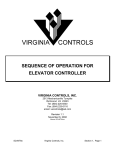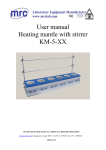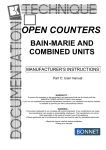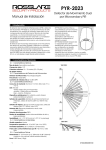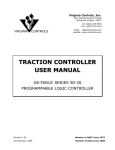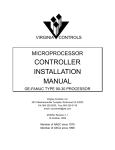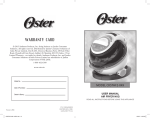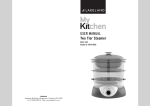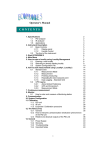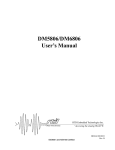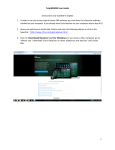Download No Slide Title - Restaurant Supply Store
Transcript
OPERATING INSTRUCTIONS VISTA 60 BAKE & DISPLAY OVEN BEDIENUNGSANLEITUNG MODE D’EMPLOI GEBRUIKSAANWIJZING PLEASE READ CAREFULLY Rev 2 (01/01/2012) INTRODUCTION Each King Edward Product is individually handmade by craftsmen using traditional methods and materials. Please follow our recommendations carefully, you will then enjoy many years of excellent service and lasting good looks from this product. INSTALLATION & COMMISSIONING To avoid unnecessary damage during transit all Vista models are despatched with the four adjustable feet removed. Please screw these back into the nut insert inside the chrome legs. The feet can be raised up or down to enable the baker to be sited firmly on most surfaces: loosen the lock nut anti-clockwise with spanner; adjust foot to desired level & re-tighten nut. We recommend that wherever possible, the Vista 60 oven is sited near adequate extraction / ventilation to assist with the disposal of steam. The exterior of this appliance will get hot during operation. Suitable precautions must be taken. Make sure that the mains flex cannot come into contact with hot surfaces and that it is adjusted to the required length by a qualified person upon installation. Do not position the oven near to the edge of a counter enabling staff or customers to brush against it in passing. Position the baker so that the electrical socket can be reached easily in the event that the baker needs to be disconnected from the electric supply. Do not push excess flex under the baker. If the supply cord is damaged, it must be replaced by the Manufacturer, its Service Agent or Similarly Qualified Persons in order to avoid a hazard. The oven can be lifted from either side; it is recommended to lift from underneath the base. Please be aware that all King Edward ovens are designed so that steam created during the cooking process can escape effectively. You will notice that there are small gaps between the glass surfaces (top door and side panels) and the surrounding edges. This is a design feature; steam is meant to escape through these gaps. If there was a perfect seal in the top display/holding area condensation would form and there would be real potential for the potatoes/other foodstuff to become damp, and the doors on the top display would become misted up by condensation – thus losing the important visual appeal. OPERATING RECOMMENDATIONS The interior of this appliance will get very hot during operation. ALWAYS use an oven glove (preferably one which covers the wrist and lower arm as well) when operating the oven or removing foodstuff from it. Take particular care when opening the main oven door; the built-up steam and heat inside will escape as soon as the door is opened and could cause injury if you are standing too close. Handle all foodstuff carefully, particularly baked potatoes as occasionally they may burst in the oven or whilst being handled. WARNING – Please DO NOT rest heavy items on the main oven door when it is pulled down to the horizontal open position. Doing so may damage the hinges and affect the efficiency of the door closing mechanism and door seal. All King Edward ovens MUST be operated by suitably trained staff. Under NO circumstances should children come into contact with or operate this appliance. Always use best practise and take all reasonable precaution to avoid accidents when using this oven. INSTRUCTIONS FOR USE Take out wire trays and position potatoes or other foods ready for loading. Plug oven in at socket and switch on fan oven switch and then turn thermostat knob to the desired setting. The switch and knobs are shown in the panel below: Display Oven Main Oven Timer On/off Switch The neon light will go off in approximately 10 minutes; this will indicate that the oven has reached temperature. Using oven gloves, load the prepared trays into the oven. You may set the audible timer for the desired cooking period, this will ring and the neon light will go off when the time is up. When cooked sufficiently, the potatoes will feel soft when gently squeezed, they can then be transferred to the top display cabinet where they will be kept hot. Guide for baking times – jacket potatoes Do not use the baker with the thermostat on full, as this will invariably burn the outside of the potatoes before the inside is cooked. When the oven is fully loaded, particularly with larger potatoes, air-flow inside may become restricted, in this case it may be desirable to reduce the cooking temperature whilst increasing the cooking time. ¾ 60 x 6/8oz potatoes at 190°C - 200°C for 60 minutes approx. ¾ 45 x 10oz potatoes at 190°C - 200°C for 60 minutes approx. The Vista 60 model has an independent heater for the top display area which may be operated at any time by the ‘display oven’ switch on the control panel. However, you will need to have the main oven left on at normal operating temperature to achieve best results. For guideline purposes only please see the chart below which shows the approximate display area temperatures that can be achieved with the control knobs at different settings, eg: main oven set at 2000 C, display area at setting 4 = resulting temperature of 1100 in the top display area: Top area temp control knob setting 1 Main Oven Temp. setting 2 3 4 5 FULL 2200 C 1000 1100 1150 1200 1300 2000 C 900 1000 1100 1150 1200 1800 C 800 900 1000 1050 1100 SERVICE SHEET FOR VISTA 60 DISCONNECT FROM ELECTRICITY SUPPLY BEFORE COMMENCING SERVICE Please note – for directional purposes we always refer to the door side of the oven as the BACK; the glass side as the FRONT. 1. Replacing top oven bulb: Access is gained from either side of the top display area. Raise curved top door; lever off glass cover, unscrew bulb - replace cover ensuring cut-out in cover is over bulb housing side. 2. Replacing door seal (main oven): The rectangular shaped oven door seal is kept in place by a clip at each corner. Simply unclip the original seal and replace with the new part. Due to its shape the seal cannot be fitted incorrectly. 3. Replacing top oven bulb assembly: Remove top cover on light housing (4 x TH20 screws). Pull off wire connectors. Assembly can be removed through top oven after pushing in clamps around sides. Replace unit and reverse process. 4. Replacing top oven element: (4.1) Remove front glass (4 x TH20 screws). (4.2) Pull off wire connectors from element terminals. Remove top oven element cover. Unscrew 2 fixing screws on element plate. Lift out element. Reverse process. *Test new element by switching on main switch and turning top display oven thermostat knob to full, but turn off main oven knob. Wait until heat is felt in top oven. 5. Replacing thermal cut-out: (5.1) Remove front glass (4 x TH20 screws). (5.2) Remove wire connectors, unscrew 2 screws and remove fibre washers behind plate. Reverse process. *Important - fibre washer must be replaced between cut-out plate and oven or oven will cut-out prematurely and disable cooking process. Test oven at full temperature and allow to cycle several times. If whole oven (including lights) go off, cut-off plate needs bending away from oven - retest when cooled. 6. Replacing main oven fan: (6.1) Remove element cover inside oven by unscrewing 2 slotted screws slightly – but do not fully unscrew or remove the screws. (6.2) Unscrew central nut clockwise, remove fan blade. (6.3) Remove front glass (4 x TH20 screws). (6.4) Pull off wire connectors from fan motor, unscrew 3 nuts securing fan assembly also 3 brass washers and 3 fibre washers, remove fan assembly, check condition of fibre washers under fan assembly and if deteriorated - replace. Reverse Process. *When replacing fan assembly ensure there are fibre washers either side of back plate. *Use nut loc or similar on nuts to prevent them from coming loose!. Test oven by turning green switch on, turn thermostat to mid setting (150-200°C) towards neon. Allow oven to cycle several times, making sure fan blade does not catch on element cover. 7. Replacing main oven element: (7.1) Remove front glass (4 x TH20 screws). (7.2) Remove wire connectors from element (below fan). (7.3) Remove element cover inside oven by unscrewing 2 slotted screws slightly – but do not fully unscrew or remove the screws. (7.4) Remove 2 screws on element plate. (7.5) Pull out element and replace. Reverse process. *Test main oven. 8. Replacing thermostat: (8.1) Remove front glass (4 x TH20 screws). (8.2) Carefully open slightly the 2 clips holding thermostat sensor inside the oven. Move in line with hole the capillary passes through. (8.3) Pull capillary and sensor back through the hole and move out of the way. Pass new thermostat sensor through hole and put into position in clips. Carefully close clips back to hold sensor. *Leave new capillary slightly slack as not to pull on sensor inside oven. Tidy and secure new capillary, ensuring it is routed well away from any element and fan motor connections using cable ties. (8.4) Replace front glass panel. (8.5) Remove Control Panel (3 screws on top and 4 screws underneath). (8.6) Remove thermostat knob and 2 fixing screws. Remove old thermostat and replace with new unit. Reverse process to return unit to full working order. *Test thermostat by turning knob to approx 2000 C. Wait until neon goes out and cycles several times before turning off. ABOUT POTATOES We recommend the use of washed and graded baking potatoes as non-baking varieties take longer to cook and don’t produce such good results, King Edward, Maris Piper or Desiree are three good baking varieties although your supplier may be able to recommend others to you. Some ways you can prepare your potatoes include: Rubbing the skins in olive oil and salt. ~ (makes the skins crisper) Pricking the skins ~ (may reduce the risk of the potatoes bursting) Wrapping them in foil ~ (produces a much “wetter” potato with a soft, thin skin, also increases the cooking time, ~ not really a proper “jacket” potato). The skin of the potato will become thicker and crunchier if it is cooked for longer at a lower temperature. However once the baked potatoes are removed from the oven, the skins will become softer as they reduce in temperature. Once removed from the very hot temperature of the baking oven and placed into the lower temperature of the holding oven, the potatoes will inevitably reduce in core temperature. The display oven is intentionally at a lower temperature to prevent the potato from over-cooking; this also helps to prolong the display life of the potato. Despite being prepared and cooked in the same way, the same batch of potatoes can produce different results! Please use the method of baking that suits you best and gives you the results you want ~ HAPPY BAKING! ABOUT OTHER FOODSTUFFS As it uses fan-assisted convection cooking, the Vista 60 oven is designed to cook a wide variety of foodstuffs and not just potatoes. If you are using the oven to cook pastries you may wish to take advantage of the humidifier unit (s/s water tray approx 250mm L x 40mm W x 25mm D) included with the oven, as this will reduce the potential for the pastries to dry out whilst being held in the storage / display oven. The humidifier tray is located next to the top display area element below the perforated stainless steel element cover. For safety reasons always fill the humidifier BEFORE the oven is switched on. Simply lift the element cover and fill the humidifier tray only with cold water. You can also fill it without lifting the cover, via the circular hole in the cover, making sure the humidifier is in the correct position below. Do NOT pour water directly onto the large s/s area holding the element. CLEANING AND MAINTENANCE Always allow the oven to cool and unplug it at the socket before cleaning. Stubborn spills or marks may be removed easier when the oven is still slightly warm. To maintain the high gloss finish and visual appeal of the baker, the exterior panels should be cleaned with warm soapy water and a soft cloth followed by polishing with glass/window cleaner or a proprietary polish suitable for metalwork. Never use abrasive or corrosive materials on any of the oven surfaces. The oven interior can be cleaned using a domestic oven interior cleaner, please follow the instructions carefully. The oven trays may be removed and cleaned in warm soapy water. Do not submerge this baker in water or use any water jets to clean it. Please contact your supplier for replacement bulbs. We recommend that the solid chrome and glass surfaces should be cleaned using appropriate cleaning materials. COMPONENT LIST FOR VISTA 60 BAKE & DISPLAY OVEN 8 7 9 10 11 1 22 21 12 6 16 5 14 20 4 18 2 19 17 15 3 Index No 1 2 3 4 5 6 7 8 9 10 11 12 14 15 16 17 18 19 20 21 22 Part Description S/S frame leg Main oven door s/s Main oven door handle Main oven door hinge Main oven wire tray x 3 Main oven door seal Top display area door – glass x 2 Top display area door handle Top display area door hinge Top display area light assembly Top display area high temperature bulb Top display area element cover / perforated tray Glass side panel x 2 Adjustable foot x 4 Fan element cover Rocker Switch Temperature / timer control knob x 3 90- minute timer Red neon indicator lens Customer facing glass panel Steam vent pipe x 2 Option Aluminium baking tray Fan Motor, complete 2.6kW main oven element Main oven thermostat (500 - 2500 C) Thermal Cut-out 300W top display area element Top display area Simmerstat Mains lead power cable Part No VISTA-SSFL V60-MODSS VISTA-DH VISTA-MODC VISTA-MOWT V60-MODS VISTA-TODG VISTA-DH VISTA-TODHI 500121 400125 VISTA-TOT VISTA-GSP VISTA-FOOT VISTA-FEC 190001AN 190304 T90 190305 VISTA-FGP VISTA-SVP 700141 700000 7000022 190303V 190222 VISTA-T0E300W 600110 190201 FAULT FINDING GUIDE Nothing Works: Is the oven switched on at the socket? Is the main oven switch on? Is trip on main fuse board on? Has fuse blown in plug ? *If trip/fuse continues to trip/blow after resetting/replacing consult service engineer. * The top oven bulb may have blown - giving the impression of oven not working! If all above are OK but oven still does not heat up - see next section Oven Not Heating Up: Turn oven thermostat knob to mid setting (150 - 200ºC) in line with neon, does neon light up? Yes - look inside oven to see if fan blade is turning. No and fan not turning - consult service engineer Oven Burning Product: Is thermostat turned above 220 ºC (temperature in line with neon)? Yes - try a lower setting (180 - 200 ºC) *Larger potatoes may need cooking at lower temperature for longer to prevent over cooking outside before inside is cooked. No - does neon light go off when temperature knob is turned to low setting (below 100 ºC) or off ? No - consult service engineer. The whole oven, (lights, elements and fan) cycles off and then on again some time later indicating a replacement thermostat is required. Yes - consult service engineer. GUARANTEE All King Edward equipment is covered by a 1 year guarantee from the time of purchase; this does not effect your statutory rights. Depending on the contract you have entered into with your supplier, the guarantee may cover Parts Only or be full Parts & Labour. Please check with your supplier for confirmation. Irrespective of the level of cover certain items are not covered by the manufacturers guarantee: bulbs, fuses, main oven door seal, glass and damage to the mains lead. The manufacturers guarantee covers all components with the exceptions highlighted above – but it does not cover external surfaces and trim. Breakages to external trim (eg brass fittings, flue, etc) and the deterioration in the quality/appearance of surface panels, canopy and stainless steel interiors, which are deemed to have been caused by general wear & tear through oven usage, are not covered by this guarantee. Please check your fuses and electricity supply before calling out an engineer as service calls requested in error will be charged at the normal rate. Please have the equipment sited where it is easily accessible to the engineer and where there is adequate room to work. In the case of an oven, please ensure the product has not been used within 6 hours of the engineers visit and that it has cooled down sufficiently to work on. Most service calls will be responded to within 48 hours. However, in exceptional circumstances we may require the equipment back at our factory for investigation and repair. In these instances please allow 4 working days from collection to delivery. Persons not authorised by King Edward Catering Equipment should not attempt to repair/adjust any part without our prior consent as this may invalidate our guarantee as would the fitting of non specified parts. Please contact King Edward on 01885 489200 or your equipment supplier if you have any problems. For future reference please write your equipment serial number here:







